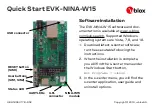
JTAG/
UART
Micro
SD
24-V to 5-V
DC-DC
Reset
button
Ma
g
n
e
ti
cs
Input: 24 V
(17 V to 60 V)
Micro
USB
DDR3
Status LEDs
10/100/1000
Mb/s
Ethernet
PHY1
DP83867IR
RJ45
10/100/1000
Mb/s
Ethernet
PHY2
DP83867IR
6LWDUDΠ30,&
DDR3 P/S
Gigabit PHY P/S
Port 1
25-MHz clock
24-MHz
clock
Host processor
Sitara
Œ
AM3359
Ma
g
n
e
ti
cs
Status LEDs
RJ45
Port 2
25-MHz clock
Application firmware
- IPv4 TCP/IP
- UDP
- IP address:
192.168.1.10
- HTTP webserver
example
Clocking
Distribution
Network
CDCE913
25-MHz
clocks
24-MHz
clock
Copyright © 2017, Texas Instruments Incorporated
Optional access
DP83867IR through
virtual COM port
Boot application
firmware from SD card
System Overview
5
JAJU324B – March 2015 – Revised July 2017
翻訳版
—
最新の英語版資料
http://www-s.ti.com/sc/techlit/TIDU832
Copyright © 2015–2017, Texas Instruments Incorporated
EMI/EMC
規格準拠、産業用温度範囲のデュアルポート・ギガビット・イーサネットの
リファレンス・デザイン
2
System Overview
2.1
Block Diagram
shows the system block diagram. The major building blocks are the DP83867IR Gigabit Ethernet
PHY, the AM3359 Sitara Host Processor, and the power supplies.
図
図
1. System Block Diagram of TIDA-00204
2.2
Design Considerations
2.2.1
Gigabit Ethernet Overview
Ethernet has heavily expanded usage over the years. Ethernet became an attractive option for industrial
networking applications. The opportunity to use open protocols (such as TCP/IP over Ethernet networks)
help replace proprietary communications in industrial control and factory automation applications. When
using Ethernet, there are several speeds available today: 10 Mb/s, 100 Mb/s (Fast Ethernet), 1000 Mb/s
(Gigabit Ethernet), and 10 Gb/s (10-Gigabit Ethernet).
Gigabit Ethernet uses the extended Ethernet MAC layer interface, connected through a Gigabit Media
Independent Interface (GMII) layer to physical layer entities (PHY sublayers) such as 1000BASE-LX,
1000BASE-SX, 1000BASE-CX, and 1000BASE-T. The topology for a 1000-Mb/s full-duplex operation is
comparable to the 100BASE-T full-duplex mode, and the minimum packet transmission time has been
reduced by a factor of ten. The resulting achievable topologies for the half-duplex 1000-Mb/s CSMA/CD
MAC are similar to those found in half duplex 100BASE-T.






































